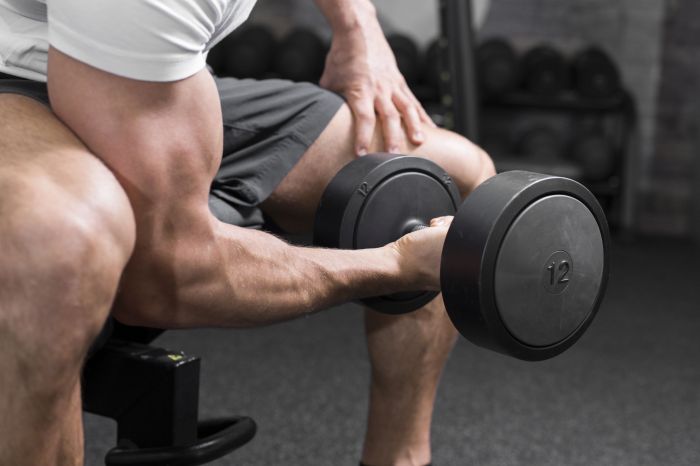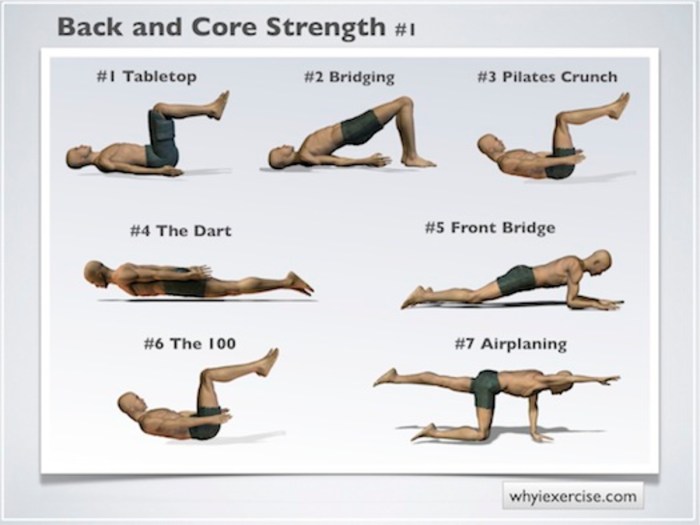How to improve muscular strength – Embark on a journey to sculpt your muscles and unlock your strength potential. This comprehensive guide will unveil the secrets to building muscular power, empowering you to achieve your fitness aspirations.
Delve into the science behind muscular strength, explore effective training methods, and discover the nutritional strategies that will fuel your progress. Get ready to witness a transformation in your strength and physique as you embrace the principles Artikeld in this guide.
Progressive Overload
Progressive overload is a fundamental principle of strength training that involves gradually increasing the weight or resistance used in exercises over time. This forces your muscles to adapt and grow stronger to meet the increased demand.
To implement progressive overload, you can:
- Increase the weight you lift in each set.
- Increase the number of repetitions you perform in each set.
- Reduce the rest time between sets.
- Increase the frequency of your workouts.
Rest and recovery are essential for progressive overload. During rest, your muscles repair and rebuild, becoming stronger. Aim for 24-48 hours of rest between workouts for each muscle group.
Progressive overload can lead to increased muscle strength, size, and power. However, it also increases the risk of injury if not implemented properly. Start gradually and listen to your body.
| Principle | Explanation |
|---|---|
| Gradual | Increase weight or resistance gradually to avoid injury. |
| Specific | Target specific muscle groups with appropriate exercises. |
| Progressive | Consistently increase weight or resistance over time. |
| Recovery | Allow adequate rest between workouts for muscle recovery. |
| Individualized | Adjust the progression based on individual fitness levels and goals. |
Compound Exercises

Compound exercises are a cornerstone of any effective strength training program. They engage multiple muscle groups simultaneously, leading to a host of benefits.
Benefits of Compound Exercises
Enhanced muscular development
Compound exercises stimulate a greater number of muscle fibers, promoting overall muscle growth and strength.
Increased calorie expenditure
These exercises demand significant energy, burning more calories compared to isolation exercises.
Improved functional fitness
Compound exercises mimic everyday movements, enhancing strength and coordination for daily activities.
Effective Compound Exercises
Barbell squats
Targets the quads, glutes, hamstrings, and core.
Deadlifts
Works the entire posterior chain, including the back, glutes, and hamstrings.
Bench press
Primarily targets the chest, triceps, and shoulders.
Overhead press
Engages the shoulders, triceps, and upper chest.
Rows
Strengthens the back, biceps, and rear shoulders.
Incorporating Compound Exercises
To maximize benefits, incorporate compound exercises into your strength training routine:
- Choose 2-3 compound exercises per workout.
- Perform 8-12 repetitions per set, for 2-3 sets per exercise.
- Rest for 1-2 minutes between sets.
Proper Form and Technique
Proper form is crucial for maximizing benefits and minimizing injury risk:
- Maintain a neutral spine, engage your core, and breathe correctly.
- Use a weight that challenges you without compromising form.
- Seek guidance from a qualified trainer if needed.
Table: Compound Exercises Summary
| Exercise | Target Muscle Groups | Execution Cues ||—|—|—|| Barbell Squats | Quads, glutes, hamstrings, core | Squat with feet shoulder-width apart, keeping chest up and knees behind toes. || Deadlifts | Posterior chain (back, glutes, hamstrings) | Hinge at hips, keeping back straight and core engaged.
|| Bench Press | Chest, triceps, shoulders | Lie on bench with feet flat, grip bar slightly wider than shoulders. || Overhead Press | Shoulders, triceps, upper chest | Stand with feet shoulder-width apart, press dumbbells overhead. || Rows | Back, biceps, rear shoulders | Sit or stand with feet hip-width apart, pull dumbbells or barbell towards chest.
|
Proper Form

Maintaining proper form during exercises is paramount for maximizing strength gains. It ensures that the target muscles are effectively engaged, minimizes the risk of injury, and optimizes results. Neglecting proper form can hinder progress and potentially lead to imbalances or strains.
Common mistakes to avoid include using momentum to lift weights, compromising range of motion, and neglecting to engage the core. For instance, during a bench press, it’s essential to lower the barbell to the chest and extend it back to the starting position with control, without bouncing the weight off the chest.
Proper form involves maintaining a neutral spine and keeping the shoulder blades retracted throughout the movement.
Tips for Improving Technique
- Study exercise demonstrations from reputable sources to understand proper technique.
- Start with a lighter weight and gradually increase it as you improve your form.
- Use a mirror or video record yourself to identify and correct any deviations.
- Seek guidance from a qualified personal trainer or fitness professional for personalized feedback.
- Focus on engaging the target muscles rather than lifting the heaviest weight possible.
Frequency and Volume
Frequency and volume are crucial factors in strength training, influencing the rate of muscle growth and strength gains. Different fitness levels demand tailored approaches to these variables.
Optimal Frequency and Volume
- Beginners:Start with 2-3 strength training sessions per week, with each session lasting 30-45 minutes. Focus on compound exercises and proper form to build a foundation.
- Intermediate:Gradually increase frequency to 3-4 sessions per week. Extend workout duration to 45-60 minutes. Add more isolation exercises to target specific muscle groups.
- Advanced:Aim for 4-5 sessions per week, with workouts lasting 60-90 minutes. Utilize a combination of compound and isolation exercises, adjusting volume based on recovery capacity.
Adjust frequency and volume based on individual goals, recovery capacity, and training experience. Listen to your body and take rest days when needed.
Relationship with Intensity
Frequency, volume, and intensity are interrelated. Higher frequency and volume often require lower intensity to allow for recovery. Conversely, higher intensity workouts may necessitate reduced frequency and volume.
Recommended Ranges
| Fitness Level | Frequency | Volume |
|---|---|---|
| Beginner | 2-3 sessions per week | 3-5 sets per exercise |
| Intermediate | 3-4 sessions per week | 5-8 sets per exercise |
| Advanced | 4-5 sessions per week | 8-12 sets per exercise |
Tips for Optimization
- Start gradually and progress slowly to avoid overtraining.
- Allow adequate rest between sets and exercises.
- Listen to your body and take rest days when necessary.
- Consider using a training log to track your progress and adjust variables accordingly.
- Seek guidance from a qualified fitness professional if needed.
Adequate Rest
Adequate rest and recovery are crucial for muscle growth and strength development. During rest, your muscles repair and rebuild, making them stronger and more resilient.
Rest Periods Between Sets:Aim for 60-90 seconds of rest between sets for strength training and 30-60 seconds for hypertrophy training.
Rest Periods Between Workouts:Allow at least 24-48 hours of rest for each muscle group before training it again.
| Exercise | Fitness Level | Rest Period |
|---|---|---|
| Compound exercises (e.g., squats, bench press) | Beginner | 60-90 seconds |
| Compound exercises | Intermediate | 90-120 seconds |
| Compound exercises | Advanced | 120-150 seconds |
| Isolation exercises (e.g., bicep curls, leg extensions) | Beginner | 30-60 seconds |
| Isolation exercises | Intermediate | 60-90 seconds |
| Isolation exercises | Advanced | 90-120 seconds |
Adjusting Rest Periods:Adjust rest periods based on your individual needs and goals. If you feel fatigued during a set, increase your rest time. If you’re not feeling challenged, decrease your rest time.
Nutrition for Strength
A balanced diet is crucial for building muscle and improving strength. Essential nutrients support muscle recovery and growth.
Macronutrients
Protein
Essential for muscle building and repair. Aim for 1.2-1.7 grams per kilogram of body weight daily. Good sources include lean meats, poultry, fish, eggs, and dairy products.
Carbohydrates
Provide energy for workouts. Complex carbs, like whole grains, fruits, and vegetables, release energy gradually.
Fats
Essential for hormone production and cell function. Choose healthy fats from sources like avocados, nuts, seeds, and olive oil.
Sample Meal Plan
Breakfast:Oatmeal with berries and nuts Lunch:Grilled chicken salad with quinoa and vegetables Dinner:Salmon with roasted vegetables and brown rice Snacks:Greek yogurt, protein shake, trail mix
Warm-up and Cool-down

Warming up before and cooling down after strength training workouts is crucial for optimal performance and recovery.
Warming up prepares your body for the strenuous activity, gradually increasing your heart rate, body temperature, and blood flow to the muscles. This reduces the risk of injuries, improves range of motion, and enhances muscle activation. Cool-down helps your body transition back to a resting state, reducing muscle soreness, promoting flexibility, and aiding in recovery.
Warm-up Exercises
- Light cardio: 5-10 minutes of brisk walking, jogging, or cycling.
- Dynamic stretching: Controlled movements that involve moving the joints through their full range of motion, such as arm circles, leg swings, and torso twists.
- Activation exercises: Bodyweight exercises that target the muscles you’ll be using in your workout, such as bodyweight squats, push-ups, and lunges.
Cool-down Exercises
- Static stretching: Holding a stretch for 15-30 seconds, such as stretching the hamstrings, quadriceps, and calves.
- Foam rolling: Using a foam roller to apply pressure to muscles, promoting relaxation and reducing muscle tension.
- Light cardio: 5-10 minutes of easy walking or cycling to gradually lower your heart rate.
Bodyweight Training
Incorporating bodyweight exercises into strength training programs offers numerous advantages. These exercises require no special equipment, making them accessible to anyone, anywhere. They also promote functional strength, which translates to improved performance in daily activities and reduced risk of injury.
Effective bodyweight exercises for improving muscular strength include:
Squats, How to improve muscular strength
- Start with feet hip-width apart, lower body as if sitting back into a chair, keeping chest up and knees aligned with toes.
- Push back up to the starting position, engaging glutes, quads, and hamstrings.
Push-ups
- Place hands shoulder-width apart on the floor, shoulder blades engaged, body in a straight line from head to heels.
- Lower chest towards the floor, bending elbows, then push back up to the starting position, working chest, triceps, and shoulders.
Pull-ups
- Hang from a bar with hands shoulder-width apart, palms facing forward.
- Pull body up until chin reaches the bar, then slowly lower back down, targeting back muscles, biceps, and forearms.
Lunges
- Step forward with one leg, bending both knees, keeping front knee aligned with ankle and back knee close to the ground.
- Push back up to the starting position, working quads, hamstrings, and glutes.
Planks
- Start with forearms on the floor, elbows aligned under shoulders, body in a straight line from head to heels.
- Hold this position, engaging core muscles, shoulders, and back.
Isometric Exercises

Isometric exercises involve holding a static position against resistance, without any noticeable joint movement. They are effective for building muscular strength because they engage the muscles in a sustained contraction, leading to increased muscle fiber recruitment and activation.
Benefits of Isometric Exercises
Improved muscular endurance and strength
Isometric exercises help enhance muscle endurance by maintaining tension for extended periods, leading to greater strength gains.
Reduced risk of injury
By strengthening muscles around joints, isometric exercises can improve stability and reduce the risk of injuries during dynamic movements.
Improved posture
Isometric exercises can help strengthen core muscles and improve posture by promoting proper alignment of the spine and reducing muscle imbalances.
Enhanced rehabilitation
Isometric exercises are often used in rehabilitation programs to strengthen weakened muscles and improve mobility after injuries or surgeries.
Examples of Isometric Exercises
Wall sit
Hold a seated position against a wall, keeping your knees bent at a 90-degree angle.
Plank
Hold a push-up position with your forearms on the ground, keeping your body in a straight line from head to heels.
Calf raise
Stand with your feet flat on the floor, then raise up onto your toes and hold the position.
Glute bridge
Lie on your back with your knees bent, then lift your hips towards the ceiling and hold the position.
Eccentric Training
Eccentric training is a highly effective method for building muscle strength and size. It involves lengthening the muscle under load, which creates micro-tears in the muscle fibers. This damage triggers the body’s natural repair process, leading to increased muscle growth and strength.
Benefits of Eccentric Training
- Increased muscle damage
- Enhanced muscle protein synthesis
- Improved neural adaptations
- Reduced muscle soreness
Examples of Eccentric Exercises
Eccentric exercises can be incorporated into any training program. Some common examples include:
- Barbell bench press (lowering phase)
- Dumbbell bicep curls (lowering phase)
- Leg press (lowering phase)
- Calf raises (lowering phase)
Mechanisms Involved in Eccentric Training Adaptations
Eccentric training adaptations involve a complex interplay of physiological and cellular mechanisms. These include:
- Increased muscle damage
- Enhanced muscle protein synthesis
- Improved neural adaptations
- Reduced muscle soreness
Plyometric Exercises
Plyometric exercises are explosive movements that involve rapidly stretching and contracting muscles, which helps to enhance muscular strength and power. These exercises are highly effective in improving athletic performance and overall physical fitness.
Effective Plyometric Exercises
Some effective plyometric exercises that can enhance muscular strength and power include:
- Box Jumps:Jumping onto a raised platform helps to develop leg strength and power.
- Depth Jumps:Jumping down from a raised platform and immediately jumping back up challenges the muscles to generate explosive force.
- Clap Push-Ups:Performing a push-up and clapping the hands at the top of the movement engages the chest, shoulders, and triceps.
- Tuck Jumps:Jumping up and bringing the knees towards the chest while in mid-air targets the core, legs, and hips.
- Medicine Ball Slams:Throwing a medicine ball into the ground with force engages the entire body, improving core strength and power.
Recovery Techniques
Recovery is a crucial aspect of strength training, as it allows your muscles to repair and rebuild. Various techniques can enhance muscle recovery and minimize soreness.
Stretching
Stretching helps improve flexibility and range of motion, reducing muscle tightness and soreness. Incorporate static stretching, where you hold a stretch for 20-30 seconds, into your post-workout routine.
Foam Rolling
Foam rolling involves applying pressure to muscles using a foam roller. It helps break up muscle knots, improves circulation, and promotes relaxation.
Massage
Massage, whether self-massage or professional, can effectively reduce muscle soreness, improve blood flow, and accelerate recovery.
Consistency and Patience
Building muscular strength requires consistency and patience. It takes time and effort to see significant results, but with dedication and perseverance, you can achieve your strength goals.
Challenges and Tips for Staying Motivated
Staying consistent with a strength training program can be challenging. Obstacles such as lack of time, motivation, and soreness can hinder your progress. Here are some tips to overcome these challenges:
Set realistic goals
Don’t try to do too much too soon. Start with a manageable workout plan that you can stick to consistently.
Find an activity you enjoy
If you don’t enjoy your workouts, you’re less likely to stick with them. Find an activity that you find challenging and fun.
Make it a habit
Schedule your workouts into your day and treat them like important appointments.
Find a workout buddy
Having someone to work out with can help you stay motivated and accountable.
Reward yourself
Celebrate your progress and milestones, no matter how small.
Real-Life Stories
Many individuals have successfully overcome challenges related to consistency and patience in their strength training journeys. Here’s a testimonial from one such individual:”I used to struggle with consistency. I would start a workout program, but after a few weeks, I would lose motivation and give up.
But I realized that consistency is key to building strength. I started setting realistic goals and found an activity that I enjoyed. I also made it a habit to work out every day, even when I didn’t feel like it.
Over time, I started to see results, and my strength improved significantly.”
Key Points on Consistency and Patience
| Key Point | Description |
|---|---|
| Set realistic goals | Start with a manageable workout plan that you can stick to consistently. |
| Find an activity you enjoy | If you don’t enjoy your workouts, you’re less likely to stick with them. |
| Make it a habit | Schedule your workouts into your day and treat them like important appointments. |
| Find a workout buddy | Having someone to work out with can help you stay motivated and accountable. |
| Reward yourself | Celebrate your progress and milestones, no matter how small. |
Tracking Progress and Maintaining Motivation
Tracking your progress can help you stay motivated and on track. Keep a workout log to record your sets, reps, and weight used. Take progress photos to see how your body is changing over time. Celebrate your milestones, no matter how small.
Every step forward is a victory.
Final Conclusion: How To Improve Muscular Strength
Congratulations on completing this guide! You now possess the knowledge and tools to embark on a path of muscular strength development. Remember, consistency, dedication, and a positive mindset are the keys to unlocking your full potential. Embrace the challenge, push your limits, and witness the incredible transformation that awaits you.
FAQ Summary
What is the most effective way to build muscular strength?
Progressive overload, which involves gradually increasing weight or resistance over time, is the cornerstone of muscular strength development.
How often should I train for muscular strength?
For beginners, 2-3 strength training sessions per week are recommended. As you progress, you can gradually increase the frequency and intensity of your workouts.
What is the role of nutrition in building muscular strength?
A balanced diet rich in protein, carbohydrates, and healthy fats is essential for providing the building blocks and energy required for muscle growth and repair.
Leave a Reply